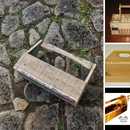Introduction: Awesome Wooden Mallet
This Mallet is made following a plan from a small paperback woodworking text called "Woodwork for Second Year" written by John A Walton first publish in 1959.
The original plans are a pleasure to follow, each step is simply written with a number and letter system corresponding to the plan. Attached are the original plans and instructions as well as a similar version drawn in mm.
This project is made from Jarrah, which is our own Western Australian hardwood. The thicker material used to make the head of the mallet is recycled from old science benches, the handle is made from new materials.
Most mallet projects are made by gluing material together to get the thickness for the head, leaving the slightly angled gap for the tapered handle. This project requires a block of timber for the head, your patience marking out the mortise to match the tapered handle and your perseverance with a chisel to create the mortise.
It will be well worth your efforts
Step 1: Preparation
Prepare material for head to required size.
Prepare handle material to required size.
Step 2: Shape Handle
Mark centre line along face, measure 15mm on each side at one end.
Join from the top corner to 15mm to form the tapering lines and plane off.
Step 3: Setting Out Mallet Head Shape
Square centre lines around mallet head.
On the face of the mallet head set out markings
- 73mm from centre line to outside edge at top
- 62mm from centre line to outside edge at base.
(If you are making this in class the material will already have this shape because cutting it with the angle saves material, you will still need to square the centre lines around)
Step 4: Mark Out Mortise
Mark position of head on handle, then place head over these lines and transfer the width of the handle up to mallet head.
Square lines across mortise gauge lines to give correct size of mortise on each edge of head.
(The mortise you create will be wider on the top of the mallet, this step transfers the correct shape of the taper you have planed on the handle)
Gauge thickness of mortise for handle with mortise gauge.
Use marking gauge to mark out mortise width on top and base of mallet head
Step 5: Chisel and Bore Mortise
Clamp the mallet head under the drill upside down at first, when you turn it over to remove material from the base remember to stay at least 10 mm from outside edges.
Sharpen a mortise chisel, clamp your work to a bench, slowly begin to remove waste mortise material to follow the tapered profile of the handle. Keep your chisel sharp and carefully create the mortise, perseverance and patience is required here.
Step 6: Shape Mallet Head
Cut off waste ends of head (marked out in step 3)
Set out and shape 280 mm radius curve on face, I suggest making a jig from scrap card and tracing it onto the mallet head.
Set out and plane faces to 50 mm thick on inside edge of head
Set out and plane a 3 mm chamfer around the three edges of both sides of mallet head
Step 7: Shape Handle
Mark shape of handle on both faces and plane to shape with spokeshave.
Mark shape of handle on both edges and plane to shape.
Round off corners with spokeshave, files and sandpaper.
Set out and plane or file a 3 mm chamfer.
Step 8: Finishing
Clean up the head with smoothing plane and a smooth then fine sand paper.
A little oil on the sole of the plane will enable it to smooth the hardwood more easily.
Use smooth than fine sandpapers to smooth handle
Assemble and apply several coats of linseed oil or a mix of natural oil and beeswax.














